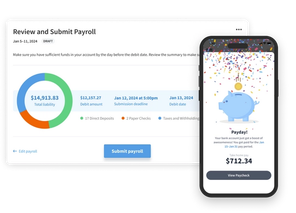
Eddy’s HR Mavericks Encyclopedia
The world's largest free encyclopedia of HR, with 700+ HR articles and podcasts.
Created by Eddy and our HR Mavericks community.
Company Goals
Company goal setting is an important part of bringing your vision to life by creating actionable steps toward your company’s mission. If you find yourself wanting things done for your business but haven’t been able to make them happen, then this is the goal-setting article for you.
What Are Company Goals?
First and foremost, company goals are something you aspire to do or attain for the betterment of your company or business. They can be organization-wide or focused on a specific area within the company and can vary in complexity and individual involvement.
Why Are Company Goals Important?
Having clearly defined company goals and steps to attain them could be the difference between growing your business and staying stagnant.
- Workforce motivation. Having goals to work toward can motivate your employees to reach them. Understanding how your goals impact the company’s success can give employees purpose and motivation driving toward specific targets.
- Employee appreciation. There is nothing quite like reaching a goal together and employees love the opportunity to celebrate these wins. Use the opportunity to recognize your workforce and pay special thanks.
- Teamwork. Having a common goal can unite your workforce. Each individual and department should be working together to help reach company targets.
- Clarified priorities. When there are well-defined company goals, everyone is clear about their priorities. Even when other things come up, everyone knows what they are ultimately working toward and can help the company accomplish it.
- Measurement for success. Part of goal setting is establishing criteria to measure the success of your efforts. By doing this, you can evaluate whether you were successful and why or why not. This information can give direction as you continue to grow and set new goals.
Types of Company Goals
The type of goal you choose should reflect what you are trying to accomplish and will likely fall into one or more of these categories.
Time-Based
Time-based goals are either long-term or short-term in nature. Long-term goals are typically high-level, overarching company goals that may take several months or years to accomplish. By contrast, short-term goals are usually segments of or stepping stones to reaching your overarching goals. Short-term goals usually range from weeks to months. For example, a long-term goal may be to make Company A the market leader in HRIS sales, and a short-term goal would be to add a new sales region to increase outreach.
Performance
Performance goals are usually short-term goals and should be well-defined and easy to measure. These goals likely impact employees directly. An example of a performance goal is to increase customer satisfaction ratings by 5% in June.
Quantitative and Qualitative
Quantitative goals are based on and evaluated by metrics like numbers or statistics. Qualitative goals are based on intangible factors like emotions or descriptors. For example, a quantitative goal may be to decrease unanswered customer service calls to only 5 a day. An example of a qualitative goal could be improving customer ratings for the new HRIS front-end design as more user-friendly.
Outcome and Process Oriented
Outcome-oriented goals are focused on end results, such as launching a new front-end design by the end of August. Process-oriented goals are more immediate and should ultimately lead to the desired outcome. A process-oriented goal could be holding biweekly status meetings with developers and marketing to maintain alignment.
Tips for Crafting Clear Company Goals
As you create goals, they should align with your company’s mission and vision and follow the SMART goal structure.
Tip 1: Specific
Goals should be stated specifically. From these you can build actionable steps. If a long-term goal is to be the market leader in HRIS sales, a specific goal could be to increase HRIS sales.
Tip 2: Measurable
Goals should be measurable so you can evaluate if they are successful. You should define the specific number or statistics you would like to reach. For example, a measurable goal is to increase HRIS sales by 25%.
Tip 3: Attainable
Your goals should be something you can attain. Setting goals that don’t align with what is doable for your business can have a negative impact on morale. Employees will feel discouraged and disinterested in attempting to reach a goal that seems unattainable.
Tip 4: Realistic
Similarly, goals should be realistic. Consider your current state and what you believe your company can realistically achieve. Remember you will continue to set new short-term goals as you achieve them to ultimately reach your long-term goals. For example, an attainable and realistic goal could be to increase HRIS sales by 10%.
Tip 5: Time-Oriented
Time-oriented, or time-bound, is the final step in building goals. Setting a timeframe for achieving your goals helps you to measure the success and evaluate their quality. In essence, making your goal time-oriented is giving it a due date. Once you reach your due date, you can review the data and know definitively if you hit your goal. For example, a time-oriented goal is to increase HRIS sales by 10% by the end of Q1.
Topics

Colleen E. Frislid, SPHR, SHRM-SCP
Colleen manages a team of HR consultants that work with a variety of industries, specializing in the fields of human resources, strategic planning, and human capital management. Colleen applies expert knowledge, industry experience, and relentless energy to solving companies’ issues. She is a member of the Society for Human Resource Management as well as women in leadership groups. She is PHR, SPHR, and SHRM-SCP certified. She has an awesome pet cat, Attila and, when she's not working she loves to travel, enjoy the great outdoors, and volunteer with different local charities.
Frequently asked questions
Other Related Terms
Eddy’s HR Mavericks Encyclopedia
Company Goals
Company goal setting is an important part of bringing your vision to life by creating actionable steps toward your company’s mission. If you find yourself wanting things done for your business but haven’t been able to make them happen, then this is the goal-setting article for you.
What Are Company Goals?
First and foremost, company goals are something you aspire to do or attain for the betterment of your company or business. They can be organization-wide or focused on a specific area within the company and can vary in complexity and individual involvement.
Why Are Company Goals Important?
Having clearly defined company goals and steps to attain them could be the difference between growing your business and staying stagnant.
- Workforce motivation. Having goals to work toward can motivate your employees to reach them. Understanding how your goals impact the company’s success can give employees purpose and motivation driving toward specific targets.
- Employee appreciation. There is nothing quite like reaching a goal together and employees love the opportunity to celebrate these wins. Use the opportunity to recognize your workforce and pay special thanks.
- Teamwork. Having a common goal can unite your workforce. Each individual and department should be working together to help reach company targets.
- Clarified priorities. When there are well-defined company goals, everyone is clear about their priorities. Even when other things come up, everyone knows what they are ultimately working toward and can help the company accomplish it.
- Measurement for success. Part of goal setting is establishing criteria to measure the success of your efforts. By doing this, you can evaluate whether you were successful and why or why not. This information can give direction as you continue to grow and set new goals.
Types of Company Goals
The type of goal you choose should reflect what you are trying to accomplish and will likely fall into one or more of these categories.
Time-Based
Time-based goals are either long-term or short-term in nature. Long-term goals are typically high-level, overarching company goals that may take several months or years to accomplish. By contrast, short-term goals are usually segments of or stepping stones to reaching your overarching goals. Short-term goals usually range from weeks to months. For example, a long-term goal may be to make Company A the market leader in HRIS sales, and a short-term goal would be to add a new sales region to increase outreach.
Performance
Performance goals are usually short-term goals and should be well-defined and easy to measure. These goals likely impact employees directly. An example of a performance goal is to increase customer satisfaction ratings by 5% in June.
Quantitative and Qualitative
Quantitative goals are based on and evaluated by metrics like numbers or statistics. Qualitative goals are based on intangible factors like emotions or descriptors. For example, a quantitative goal may be to decrease unanswered customer service calls to only 5 a day. An example of a qualitative goal could be improving customer ratings for the new HRIS front-end design as more user-friendly.
Outcome and Process Oriented
Outcome-oriented goals are focused on end results, such as launching a new front-end design by the end of August. Process-oriented goals are more immediate and should ultimately lead to the desired outcome. A process-oriented goal could be holding biweekly status meetings with developers and marketing to maintain alignment.
Tips for Crafting Clear Company Goals
As you create goals, they should align with your company’s mission and vision and follow the SMART goal structure.
Tip 1: Specific
Goals should be stated specifically. From these you can build actionable steps. If a long-term goal is to be the market leader in HRIS sales, a specific goal could be to increase HRIS sales.
Tip 2: Measurable
Goals should be measurable so you can evaluate if they are successful. You should define the specific number or statistics you would like to reach. For example, a measurable goal is to increase HRIS sales by 25%.
Tip 3: Attainable
Your goals should be something you can attain. Setting goals that don’t align with what is doable for your business can have a negative impact on morale. Employees will feel discouraged and disinterested in attempting to reach a goal that seems unattainable.
Tip 4: Realistic
Similarly, goals should be realistic. Consider your current state and what you believe your company can realistically achieve. Remember you will continue to set new short-term goals as you achieve them to ultimately reach your long-term goals. For example, an attainable and realistic goal could be to increase HRIS sales by 10%.
Tip 5: Time-Oriented
Time-oriented, or time-bound, is the final step in building goals. Setting a timeframe for achieving your goals helps you to measure the success and evaluate their quality. In essence, making your goal time-oriented is giving it a due date. Once you reach your due date, you can review the data and know definitively if you hit your goal. For example, a time-oriented goal is to increase HRIS sales by 10% by the end of Q1.
Topics

Colleen E. Frislid, SPHR, SHRM-SCP
Colleen manages a team of HR consultants that work with a variety of industries, specializing in the fields of human resources, strategic planning, and human capital management. Colleen applies expert knowledge, industry experience, and relentless energy to solving companies’ issues. She is a member of the Society for Human Resource Management as well as women in leadership groups. She is PHR, SPHR, and SHRM-SCP certified. She has an awesome pet cat, Attila and, when she's not working she loves to travel, enjoy the great outdoors, and volunteer with different local charities.
Frequently asked questions
Other Related Terms
Eddy's HR Newsletter
Sign up for our email newsletter for helpful HR advice and ideas.


